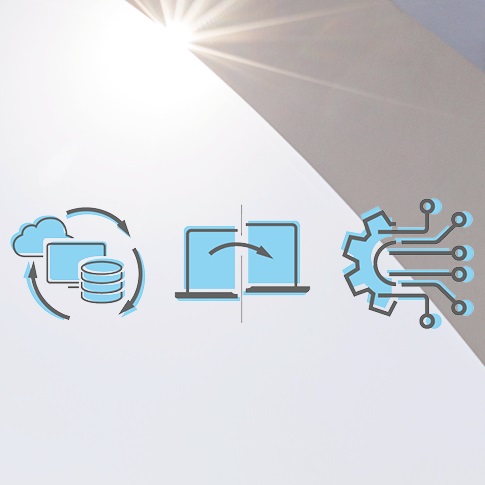Author: Fabio von Hertell, Software Architect, Layer 2 GmbH
One of the greatest inventions when it comes to computer software is something that we use everyday. It works seamlessly and silently in the background. The tasks which we perform on computers, tablets and mobile phones would be tedious, if not worthless, without it. We never think about it, as is the fate of most things that just work. I am talking about the virtual Clipboard. It enables the user to move data from any application or website to any other application while also conveniently converting it for us, if necessary.
We are so used to it, that we rarely ever give it a thought, let alone appreciate it. But think for a second about how boxed in it would make you not having it. Imagine writing a text in a text editor and you need to incorporate some information from some business application. You would have to look the info up, put both apps side-by-side and then retype all the info already on your screen.
The clipboard enables us to integrate data very easily and every application is able to work with it. It's the single most used interface to integrate applications.
Now with great power comes great responsibility. Everybody has their own share of stories about how copying & pasting led to unmanageable spreading of information, reproducing the same errors and losing important context.
If you have ever re-used a Power Point presentation for a new customer, but forgot to replace the Company logo, you know what I am talking about.
In today's data-driven world, businesses are constantly generating vast amounts of data using many different systems. There is the dreaded 100.000 line Excel sheet, a lot of old Line of Business applications, databases and cloud storages.
The data is collected and maintained by different departments for different reasons, but as far as they are related to the same business, it is almost always the case that there are
1. Redundancies
2. Outdated information in one system that has been updated in another system
3. Local information that could be valuable to other parts of the business (Data Silos)
4. Valuable Insights that could be generated by linking the data and analyzing it
What is Data Integration?
At its core, data integration refers to the process of combining data from different sources into a unified and accessible format. This amalgamation allows organizations to gain a comprehensive view of their data, enabling better decision-making, enhanced reporting, and streamlined business operations. Data integration can take many forms, including database integration, cloud data integration, and application integration, depending on the sources involved and the desired outcomes.
Key Components of Data Integration
Data Sources
These are the origins of the data, which can include databases, spreadsheets, cloud platforms, web services, and more.
Data Transformation
Data integration often involves converting data from various formats and standards into a consistent structure. This process may include data cleansing, normalization, and enrichment.
Unified Data Storage
Integrated data is stored or referenced in a centralized system, making it easily accessible for analysis and reporting. Often referred to as the "Single source of truth".
Data Delivery
Data is delivered to end-users through various channels such as dashboards, reports, or applications.
Data Synchronization
In many cases, data integration involves real-time or periodic synchronization to ensure that the integrated data is always up-to-date.
Advantages of Data Integration
Data integration offers numerous advantages that are essential for modern businesses. Let's explore some of the key benefits
Informed Decision-Making
By integrating data from disparate sources, organizations can make more informed decisions. This comprehensive view of data allows for better analysis and a deeper understanding of trends, risks, customer behavior, and market dynamics.
Enhanced Productivity
Knowing where information can be found, automating the process of relocating and transforming data, reducing the potential of mistakes and miscommunication frees up time to be used for more strategic tasks.
Better Collaboration
Data integration fosters collaboration by providing a single source of truth for all stakeholders. When teams across an organization access the same integrated data, it eliminates confusion and ensures everyone is on the same page.
Cost Savings
Efficient data integration can lead to cost savings in various ways. It reduces the need for manual data entry, minimizes data errors, and prevents duplication of effort.
Scalability
As businesses grow, so does the volume and complexity of data. Data integration solutions can scale to accommodate these changes, ensuring that the organization can continue to benefit from integrated data.
How can Layer2 Cloud Connector help you as data integration tool?
Wide Range of Data Sources
The Layer2 Cloud Connector supports an extensive array of data sources, including on-premises and cloud-based databases, file systems, web services, and more. It can read from and write to all systems which provide an ADO.NET or ODBC provider. Two widely used business standard interfaces for data access. It is even possible to create your own provider. This versatility allows organizations to integrate data from multiple platforms seamlessly.
Frequent Synchronization
In today's fast-paced business world, having your data up-to-date is crucial. Layer2 Cloud Connector offers frequent data synchronization capabilities, ensuring that your data is always up-to-date.
Data Transformation
With it's "Dynamic Column" Feature, which is essentially a programmable data column, the CloudConnector is able to perform complex operations on your data, to clean, transform or convert to match your requirements.
Keep your data where you want it
The CloudConnector is a standalone application, which can run on any server. If you run it on-premise, there is no need to expose any of your data to the internet. While any data that you want to have in the cloud can also be integrated.
Microsoft Integration
For organizations heavily invested in Microsoft technologies, Layer2 Cloud Connector offers deep integration with SharePoint, Office 365, and other Microsoft products, making it an ideal choice for enhancing collaboration within the Microsoft ecosystem.
Conclusion
Data integration is the cornerstone of effective collaboration in the modern business landscape. It empowers organizations to break down data silos, make informed decisions, and operate more efficiently. With Layer2 Cloud Connector's comprehensive data integration capabilities, businesses can unlock the full potential of their data, driving collaboration and innovation across the board. Embrace data integration as the catalyst for better collaboration, and let Layer2 Cloud Connector be your trusted partner on this transformative journey.


